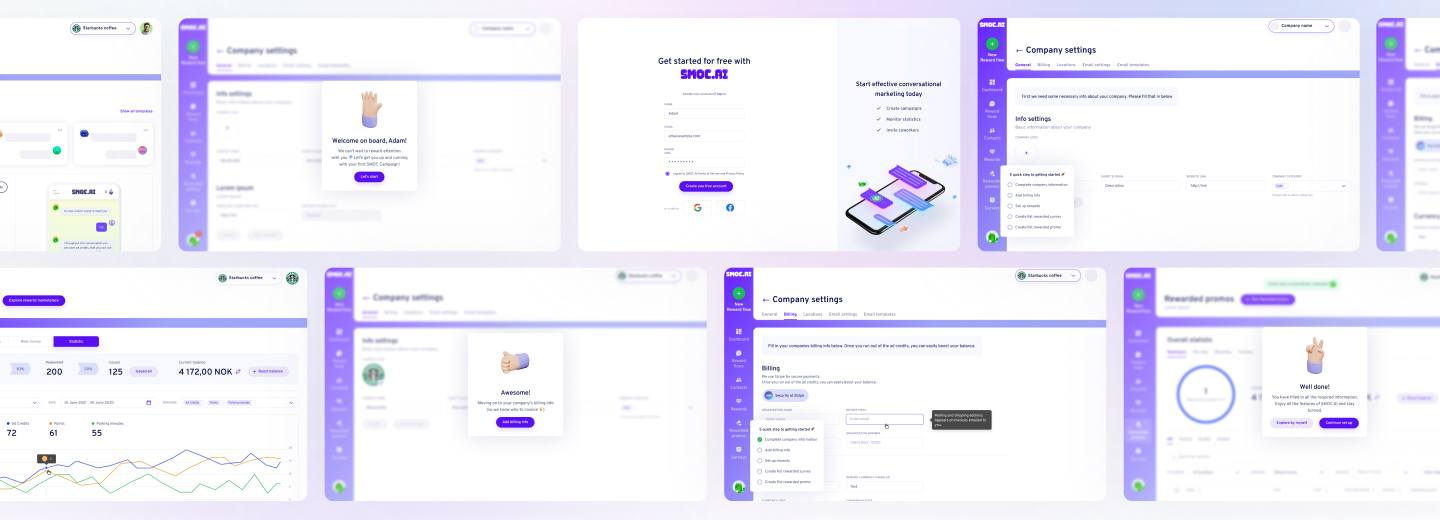Having once tried to sell the idea to investors, partners, or even your employees, you must have noticed that clarity of the problem description and a solution presentation may decide whether the conversation can be successful or not.
A pitch deck “Problem Solution” isn’t just a formality; it is where you prove that you know the issue inside and out and have a smart method of resolving it. The more you can relate these two dots, the more your audience can identify why what you have to say is relevant and that it is of any importance that they need to listen to you.
TL;DR
The Problem and Solution slide must be easy to comprehend and list what problem your target audience is struggling with, and how your product or service directly addresses it. Keep it simple, relatable, and provide facts or problem slide pitch deck examples of why your idea is worthwhile.
what’s in the article
- Why a Problem Solution Slide Matters in Your Pitch Deck
- Core Elements for Powerful Problem Solution Slides
- How to Present the Problem
- How to Present the Solution
- Common Mistakes to Avoid
- Design Tips for an Engaging Problem Solution Slides
- Conclusion
Why a Problem Solution Slide Matters in Your Pitch Deck
Decision-makers and investors are exposed to hundreds of pitches, and most of them are similar. The difference that makes yours unique is that you can bring something much more effective and practical to real problems. In this problem slide, you demonstrate that you know the pain points in the market and that it isn’t just a concept, but you have a good product developed to address their problem. An effective Problem Solution slide establishes credibility, generates a sense of urgency, and sets your remaining presentation up to be heard with authority.
Core Elements for Powerful Problem Solution Slides
An effective Problem Solution slide represents more than a problem and a solution; it is a persuasive story that makes an impression on the listeners. To make yours be distinct, concentrate on the following:
Concise Problem Statement
The audience must be well-versed in the problem that you are solving before you can sell your solution. That is why your problem statement must be brief, accurate, and understandable at a glance. don’t clutter it up with industry jargon or technical terms that only the in-crowd will understand, but rather write it like you were explaining it to a person who had no idea how the industry works. A good indicator that you have hit it on the nail is this: when you speak out a problem to someone and the person can repeat the same in their own words. The idea is to convince them that it is an actual problem and that it can be solved.
Relatable Storytelling
Stories are important, whereas people relate to facts. A brief, relatable example can make a theoretical issue a tangible one, which your readers and audience can touch. It might be a brief customer narrative or personal experience, a brief day in the life scenario depicting the pain point in action. When it is possible to imagine the problem in the real person, perhaps oneself, the necessity to solve it becomes real. It is a trick to make it short and as vivid to trigger some emotion.
Solution & Unique Value
After having clarified the problem, it is time to find the answer. Make a profound product discovery, and present your solution as though the audience has been waiting to hear it. Then, ensure that your unique value cannot be ignored – whether it’s speed, cost-effectiveness, innovations, convenience, or a thoroughly new approach. This isn’t merely your solution but why your solution is the best possible solution as compared to doing anything else. When your audience peruses this section, they need to be thinking, “That makes perfect sense, and nobody is doing it that way.”
Data & Visual Support
Any story, no matter how interesting it is, must be substantiated. And here, frequently selected statistics, charts, and even brief bullet lists are used. They help to emphasize the fact that the issue is serious and the solution is effective. Make the design simple and don’t overload one problem slide with the information, as viewers are supposed to comprehend what they see within several seconds. When presented properly, your data can do more than lend credibility to your message; it can also provide your message with a lasting impression after the pitch is past.

Looking to Build an MVP without worries about strategy planning?
EVNE Developers is a dedicated software development team with a product mindset.
We’ll be happy to help you turn your idea into life and successfully monetize it.
How to Present the Problem
Your tone in your problem slide pitch deck when you introduce the problem will determine how seriously your solution is going to be taken. Your presenters should convince your audience that the problem is real and that it must be solved immediately.
Clearly Define the Core Problem
Start with the simple, most succinct statement of the problem. An example is, rather than saying, “Communication inefficiencies are a problem in the real estate industry across the platforms and stakeholders”, you could say, “Property buyers experience an average of 3 weeks of waste as a result of poor communication between agents, banks, and sellers.” The latter version is brief, precise, and gives a vivid picture. The more articulately you put it, the more quickly your audience puts the odds on the table.
Show the Real-World Impact
After defining the problem, make it feel real. Explain the impact it has on individuals, companies, or the economy. For example, if you are selling a productivity tool, you could say something like this: “On average, employees waste 21 minutes each day switching between work tools – that comes to over 90 hours per employee annually.” This form of framing makes an intangible waste of concrete. Once the readers have a picture of the results of their choices, they will be more likely to see a reason to seek a solution.
Support with Data or Trends
The numbers make your allegations believable. Provide statistics in use of an industry, research, or reputable report that demonstrates this isn’t simply your experience, but that it is a documented, pervasive issue. As an example, Gartner found out that a company loses on average 12.9 million yearly due to poor data quality. Providing that you are also able to demonstrate the rate at which the problem is expanding, you can do so by showing that market demand is rising, complaints in use, or gaps in technology. You can further reinforce the argument that the problem needs to be acted upon now.
Highlight the Urgency
An issue with a solution that can be accomplished sometime in the future is hardly an investment motivator. Demonstrate why the problem needs to be handled now and not later. And perhaps it is a new law taking effect, a sudden shift in consumer behaviour, or a rival starting to take control in the space. Remote working has increased by 44% over the last three years, and 60% of teams fail to have appropriate tools to collaborate virtually successfully, so the potential is huge. Urgency helps your audience move interest into action.
How to Present the Solution
After capturing attention with the problem, this is your moment to position your idea as the clear and compelling answer. The best solutions are presented in such a way that it seems a logical continuation, and the audience should be almost anticipating your idea by the end of it. Make it straightforward, believable, and motivating, and then they immediately know what makes it work and what makes this worth giving funds.
Present a Concise Overview of Your Solution
Begin with a one- or two-sentence description stating things right to the point. Be sincere in your intent to provide information, not confusion, to your audience. Don’t load a lot of technical jargon into what you say. As an example: “Our platform automates the process of tenant screening and can take up to 5 days to be approved, and can now target and achieve only 24 hours to complete.” Such a swift, result-oriented statement instantly sends a signal of value and preconditions for further elaboration. And remember, you can dig into the how later during the pitch; it is all about the what and the why it matters.
Emphasize What Makes It Unique
A solution could be efficient, yet, in order to impress investors or decision-makers, it should be special. Point out those differentiators that can not be easily replicated by competitors- and this might be proprietary technology, exclusive partnerships, a patented process, or a distinctive customer experience. For example: “Unlike existing fitness apps, our AI-powered workout planner adapts to real-time biometric data, delivering truly personalized training.” By clearly identifying your edge, you make it harder for your audience to dismiss you as “just another option.”
Showcase the Real-World Impact
Explain not only your solution but also demonstrate it. Wherever possible, suggest some initial findings, customer reviews or test case success. Numbers make it even more impressive: “During our beta test with 200 small businesses, we reduced invoicing errors by 73%, and saved each company, on average, 12 hours a month.” Real-life evidence provides your audience with something tangible to grasp, and it also gives the audience a step towards tangible value and concept.
Highlight Key Benefits and Future Potential
Your audience doesn’t only need to know how your solution is working today but also how far it can reach in the future. Illustrate the main advantages in such a manner that relates to the presented problem. Next, mention briefly your growth potential or: new markets, more features, or scalability. As an example, we target freelancers and small businesses today, but could quickly start targeting enterprise clients, which is a $4.5B market. This demonstrates that you don’t only have in mind to solve a problem today, but would also create something that could be developed in the future and dominate the market.

Proving the Concept for FinTech Startup with a Smart Algorithm for Detecting Subscriptions

Scaling from Prototype into a User-Friendly and Conversational Marketing Platform
Common Mistakes to Avoid
A lot of pitch decks fail not due to a weak solution, but rather due to the presentation itself being difficult to grasp or relate to by the audience. Knowing these pitfalls may help your pitch avoid confusion that is unnecessary and help your solution stand out.
Overloading Slides with Too Much Data
You are tempted to put all the numbers, charts, or other metrics that you have obtained, but at some point, your audience will have too much to follow. Slides that are full of numbers or text tend to make the viewer either skim or lose attention altogether. Rather, pay attention to the most convincing data points. Take one of the main statistics that illustrates the magnitude of the issue, accompanied by a basic graph that further supports your idea. This is a way to maintain your message straightforward and memorable.
Using Generic or Vague Descriptions
Phrases such as “we solve big problems” or “our solution is innovative” don’t convince anyone — they’re too vague. Avoid generalities, be specific about the problem, the solution, and the value you offer. An example is, rather than “Our app allows businesses to manage tasks,” change it to, “Our app automates assigning tasks across teams and eliminates 40% project delays.” Your pitch deck problem solution slide should be actionable and believable because concrete, measurable statements are used.
Ignoring the Target Audience’s Perspective
Your slides have to address the interests, concerns, and the level of knowledge of the audience. The investors seek the potential in the market and the ROI, whereas potential partners may be interested in efficiency or integration. Even the most innovative solutions can prove to be a failure in case you fail to tailor your message. To find out, ask yourself: “What do I want to know first, if I were in their shoes?”
Relying on Poor or Misleading Visuals
Images are effective; however, poor graphs or misleading illustrations may hurt the reputation. It isn’t advisable to use skewed graphical representations, irrelevant pictures, or designs that might be complex and only increase confusion instead of clarity. Include clean and correct visuals in your message. To follow this up, an example of a simple bar chart that compares the results of your solution with those of the traditional methods is much more effective than an overly detailed and distracting infographic. Note: clarity always wins over style for persuasion.
Design Tips for an Engaging Problem Solution Slides
It is possible that after your strongest problem and solution, the message might lose its impact, seeing that your slide will look cluttered or confusing. Aesthetics aren’t the only effect that good design produces; rather, it helps direct the gaze of the audience, remembers key points, and adds a visual spin to the story. These hints will assist you in designing slides that look good and that convince.
Bold, Impactful Headline & Ample Whitespace
Begin with a headline that conveys straight away the key message of your slide. Namely, it must be concise, clear, and eye-popping. It is also important to remember to include whitespace; don’t bunch everything up together. Allowing your content to breathe gives the audience an easy way of concentrating and avoids thinking about too many things. For example, a headline like “90% of Remote Teams Face Problems in Task Management” and a straightforward visual underneath immediately catches the attention of what is important.
Minimalist Layout with Consistent Styling
A uniform, clean design maintains attention on the message, rather than having your audience lose concentration on the message through random colors, fonts, and shapes. Use a single or two fonts, a consistent color scheme, and spacing on problem and solution slides. Boring, it isn’t, though minimalism does mean that everything is functional. A clean layout would enable your audience to think in a logical progression through the problem down to the solution without getting lost.
High-Quality, Relevant Visuals
Your points must not be cluttered with images, charts, and icons. Apply such visuals that are directly related to your story – for example, a bar graph or a simple listing of time saved by your solution or a photo of a customer with a problem. You don’t want to use low-resolution or generic stock photography and make your slide feel amateurish. Good quality visuals will help your slide to appear professional and more trustworthy.
Concise Text with Visual Hierarchy
Make reading brief and easy to scan. Break the ideas or keep the ideas short and put a visual hierarchy to it using size, boldness, or color. This takes the audience through the slide in the desired sequence. As an example, type the problem statement as the largest font, key metrics slightly under that, and supportive details in a smaller font size. This will make sure that the first impression of your readers is the most significant information, and it doesn’t overload them with text.

Need Checking What Your Product Market is Able to Offer?
EVNE Developers is a dedicated software development team with a product mindset.
We’ll be happy to help you turn your idea into life and successfully monetize it.
Conclusion
An effective pitch deck solution slide is where you get to demonstrate that there is a problem and that you do have a solution. Make it specific, to the point, and appealing to see: state the problem that you are solving, show how your solution can add something unique to it, and never leave behind the evidence or pictures. Keep it uncluttered, non-vague, or non-relevant, or avoid details, and also make sure that you customize your message to the audience.
In case of projects where you require professional assistance when developing pitch decks that will make an impression, EVNE Developers’ pitch deck consulting services can help create professional, convincing presentation slides that can draw attention to your problem, solution, and growth potential. We can help you make your pitch deck get noticed and attract investors to see the importance of your idea at a glance.
Discuss with your target audience, do research on pain points, and see what people experience in the real world. A proper problem is specific and easy to identify, whereas the solution must be focused.
Make it short, exact, and to a real pain point. Define who is impacted, what the issue is, and why it is important, and use examples or numbers as much as possible.
It is a rule of thumb that recommends 10 slides, a 20-minute talk, and at least a 30-point font so that your presentation would be clear, short, and legible.
A pitch deck is specifically used to present a business idea to investors or stakeholders with an emphasis on problem, solution, market, and growth. The slide deck can describe any set of slides of any purpose that are used in slide presentations.

About author
Roman Bondarenko is the CEO of EVNE Developers. He is an expert in software development and technological entrepreneurship and has 10+years of experience in digital transformation consulting in Healthcare, FinTech, Supply Chain and Logistics.
Author | CEO EVNE Developers


















